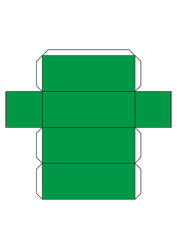

Develop spatial imagination
0.00 $
0 item(s)
Regular quadrangular prism
A quadrangular prism is a polyhedron, the two faces of equal squares lying in parallel planes, and the remaining faces (side faces) are parallelograms that have common sides with these.
A regular quadrangular prism is a quadrangular prism whose bases have squares, and the side faces are rectangles.

Prism bases are equal to regular squares.

The side faces of the prism are rectangles.

The side edges of the prism are parallel and equal.

The dimensions of the prism can be expressed in terms of side length a and height h.

The prism total surface area is equal to its lateral surface area and the base's doubled area.
The formula of the surface area of a quadrangular prism:


The volume of a prism is equal to the product of its height and base area.
The formula of volume of a regular quadrangular prism:


The regular quadrangular prism can be inscribed into the cylinder.
The formula for the radius of the cylinder:



Historically, the concept of "prism" arose from Latin and meant - something sawed.
The animation demonstrates how two parallel planes cutting off the excess from the two bases of the prism. From a single workpiece, you can get both the regular prism and an oblique prism.

Geometric dimensions of the finished prism (mm):
Length = 68
Width = 68
Height = 52

Geometric dimensions of the finished prism (mm):
Length = 59
Width = 59
Height = 83

Geometric dimensions of the finished prism (mm):
Length = 43
Width = 43
Height = 110
Popular
Is it possible to cut a triangle into such several parts so that one can put a square together?...
One can specify the following mathematical characteristics in each of the five Platonic solids: 1....
The Kepler's Star (nor Keplerstjernen), 45 meters high, is located near Oslo in Gardemoen Airport. A huge...
When we demonstrate polyhedra assembled from the Magic Edges set, people often ask the same question...
For a primeval man, fire once became a new form of social life. The night ceased to be an...
The monument to the “Truncated large dodecahedron” polyhedron was discovered in Obninsk (Russia)...
Imagine a historic building, an architectural ensemble that is decorated with stellated polyhedra. And...




